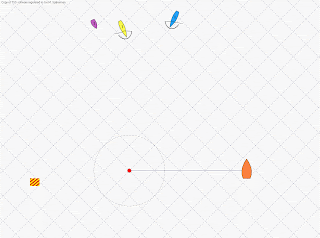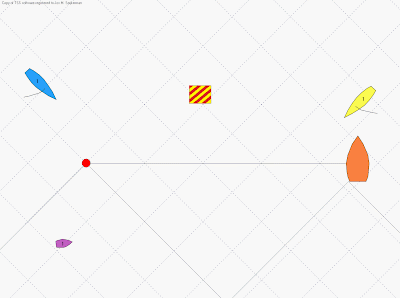Continued from this post.
The IJ Test is composed in 3 parts: The first part (A) is about rules in Part 2 of the Racing Rules of Sailing, the second part (B) mostly about procedures and the other rules and finally the third part (C) in which you are required to write 2 protests including facts found, conclusion, rules that apply and a decision.
Part A is about the right-of-way rules and definitions. You are presented with a situation / diagram and a couple of facts. You have to answer 5 or 6 questions about that situation. Each right answer earns you points, each wrong answer gets you negative points which are deducted. I still have a couple of test-question - which I'm not allowed to publish - so I'll try to make a few similar in the future and publish those, to give you a idea of the structure and level.
Part B is about all those procedural issues, who's allowed to protest who and why or why not. How a Jury is suppose to be composed, how a hearing is to be conducted, all kinds of request for redress, OCS, BFD, etc. etc. That kind of stuff. Not the most glamorous - I know - but essential if you want to be an IJ. At International Events there's no possibility of appeal, therefore all issues must be decided by the Jury. Measurement issues, class rule interpretations, entry requirements, NoR, SI's, scoring etc. And lets not forget, all rule 69 issues. In short, you become the final say so in all matters and better be ready for the task. A jury can overrule the Organizing Authorities or the Race Committee if need be, and you need to know why you have to reach that unpopular decision.
Again, as in part A, a case is presented on which several questions are put to you. Don't expect to pass on the multiple choice principle. Answers are similar enough to have to know which one is correct, instead of guessing.
Best advice I can give you in answering part A and B, is to read very carefully what is asked, don't assume it is a trick question, don't assume anything that is not stated, other than it being a normal situation. The rules are to be used as they are written, not as you think they should be. The same is true of these exam questions.
Finally Part C, writing two protests. You are presented with a situation and a couple of facts, by means of a diagram. One or both boats have handed in valid protests and you are asked to write it. Now, because you cannot ask the parties or witnesses, you will have to "guess" a couple of facts. That's perfectly alright. Try to stick to the diagram, but even if you don't, that is not the issue.
First, you need to write down all relevant facts to make a decision based on the rules. Don't leave one out. If a boat has changed tack, somewhere in between, she either passed head to wind or she gybed. Include those facts in your list if they are relevant to your conclusions and decision.
Secondly, you need to be consistent. If you draw a conclusion which is not based on a facts found, you are in trouble. Any fact found should have meaning i.e. is needed to draw a conclusion. Simply put, if you disqualify a boat on rule 10, you better have a fact stating one boat is on port and one boat is on starboard tack. Sounds obvious, but needs practicing to get it right. Again for instance, if there is not a fact stating that a boat touched a mark, you cannot use rule 31.1 in your decision.
Third, in your facts found, you should not have any conclusions. For instance, stating that a boat luffed to avoid the other, is already a conclusion. Better is to find as fact that at x meter apart, boat A luffed and that boat B didn't change course. You can then in your protest conclusions state that A complied with rule 14 by luffing to avoid the contact. Finally, stick to the terminology of the rules. Use the words of the relevant rule(s) to state your conclusion. (
Look at this posts how to do that)
My advice on how to use your time: go over part A and B in about an hour each, you'll have 30 minutes to do part C. (60-60-30 for Non-English and 50-50-20 for English) Don't dwell on a question to long, there are plenty more. Bring your watch and check. You'd be amazes how quickly time flies, when you are concentrating.....
You are allowed to use a (clean) rulebook in your language, but I would suggest you bring an English one (or both). Don't expect that you have time to look things up, but for short checks it's handy. You should be totally familiar with the structure if the rulebook, so you don't waste time finding what you want to check. Basically you should be able to answer without a rulebook, but you can check for instance, a rule number or the maximum weight of clothing or stuff like that. If you are not sure about an answer make a small circle at the top of the page. If you have time at the end, you can back to the pages with a circle and think some more. In my experience however, it doesn't help second guessing yourself. But sometimes it's the other questions who have given you the insight in answering that one.
Passing grade is 80% for each part. Which means that you need to score 80% of the questions correctly in each of part A and B, and have a 80% score in part C.
Fail one part - no matter how good the others - and you fail the exam. My latest information was, that you then only had to resit the failed part, not the whole exam, but that turned out to be incorrect: When you fail one part you have to do the whole exam again, but not within 6 months. Most seminar-exams have a pass-rate of about 20-25%. One in four or five. Results are confidencial. If you want to know, you'll have to ask individual participants, ISAF does not give information on that subject. They do publish a general report on the website about conducted seminars.
This post concludes the series on IJ-seminars. Don't hesitate to ask if you want to know more. If I don't know the answer, I'll try to find out, or point you in the right direction.




























